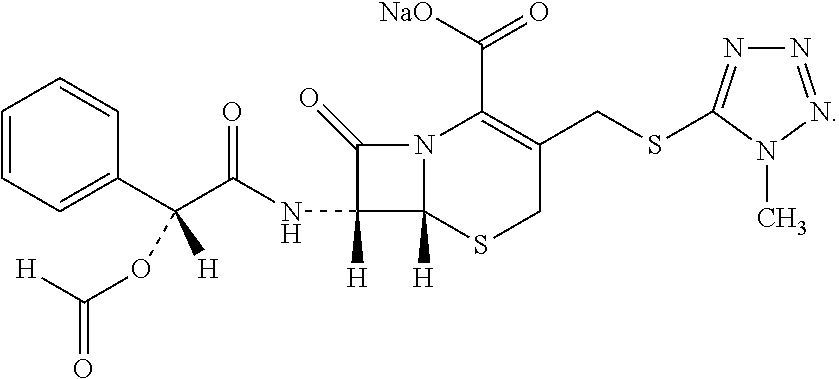Refining process of cefamandole sodium
a cefamandole sodium and refining technology, applied in the field of medical technology, can solve the problems of complex process of this method, high production cost, and high production cost, and achieve the effect of reducing the cost of production, and improving the quality of production
- Summary
- Abstract
- Description
- Claims
- Application Information
AI Technical Summary
Benefits of technology
Problems solved by technology
Method used
Image
Examples
example 1
[0059]10 g of cefamandole nafate with a purity of 95%, prepared according to U.S. Pat. No. 4,351,947A, was weighted exactly. The solution containing cefamandole nafate was loaded into a fixed bed filled with D001 strongly acidic styrene-based cation exchange resin before the exchange proceeded until the pH value was adjusted to 3.3. Then an elution was performed using 10% aqueous solution of hydrochloric acid as the eluent to obtain an eluate which was collected and concentrated under reduced pressure. At this time, the purity was examined by HPLC as 97.5%. The pH value was adjusted to 6.8 with 1M aqueous solution of sodium hydroxide while the temperature was raised to 50° C., and filtered out the insoluble substances with heating. At this time, the purity was examined by HPLC as 98.4%.
[0060]The temperature was raised to 70° C. and keeping for 20 minutes, in order to vaporize excessive moisture from the solution of cefamandole nafate. Then absolute ethanol in a volume ratio between ...
example 2
[0063]10 g of cefamandole nafate drug with a purity of 97% was weighted exactly. The solution containing cefamandole nafate was loaded into a fixed bed filled with D201 strongly acidic styrene-based cation exchange resin before the exchange proceeded until the pH value was adjusted to 2.8. Then an elution was performed using 50% solution of sulfuric acid as the eluent to obtain an eluate which was collected and concentrated under reduced pressure. The purity was measured by HPLC as 98.5%.
[0064]The pH value was adjusted to 7.5 with 2M aqueous solution of sodium carbonate while the temperature was raised to 65° C., and filtered out the insoluble substances with heating. At this time, the purity was measured by HPLC as 99.1%.
[0065]The temperature was raised to 80° C. and keeping for 30 minutes, in order to vaporize excessive moisture from the solution of cefamandole nafate. Then absolute ethanol in a volume ratio between ethanol and water of 4:6 was added in batch, and the temperature ...
example 3
[0068]10 g of crude cefamandole nafate with a purity of 96%, prepared according to EP0432297, was weighted exactly. The solution containing cefamandole nafate was loaded into a reactor filled with GB / T 13659-2008 001×7 strongly acidic styrene-based cation exchange resin, and CO2 gas is introduced for promoting the exchange, until the pH value was adjusted to 3.1. Then an elution was performed using 15% aqueous solution of hydrochloric acid as the eluent to obtain an eluate which was collected and concentrated under reduced pressure. At the time, the purity was measured by HPLC as 97.9%.
[0069]The pH value was adjusted to 6.6 with 1M aqueous solution of sodium acetate while the temperature was raised to 60° C., and filtered out the insoluble substances with heating. At this time, the purity was measured by HPLC as 98.8%.
[0070]The temperature was raised to 80° C. and keeping for 15 minutes, in order to vaporize excessive moisture from the solution of cefamandole nafate. Then absolute e...
PUM
| Property | Measurement | Unit |
|---|---|---|
| temperature | aaaaa | aaaaa |
| temperature | aaaaa | aaaaa |
| temperature | aaaaa | aaaaa |
Abstract
Description
Claims
Application Information
 Login to View More
Login to View More - R&D
- Intellectual Property
- Life Sciences
- Materials
- Tech Scout
- Unparalleled Data Quality
- Higher Quality Content
- 60% Fewer Hallucinations
Browse by: Latest US Patents, China's latest patents, Technical Efficacy Thesaurus, Application Domain, Technology Topic, Popular Technical Reports.
© 2025 PatSnap. All rights reserved.Legal|Privacy policy|Modern Slavery Act Transparency Statement|Sitemap|About US| Contact US: help@patsnap.com

